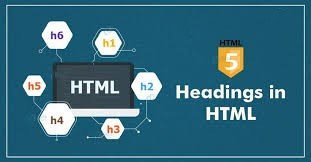HTML Tutorial
- HTML HOME
- HTML Introduction
- HTML Editors
- HTML Basics
- HTML Comments
- HTML Elements
- HTML Attributes
- HTML Headings
- HTML Paragraphs
- HTML Styles
- HTML Text Formatting
- HTML Quotations
- HTML Colors
- HTML Links
- HTML Images
- HTML Favicons: How to Add and Optimize for All Browsers
- HTML Page Title: How to Optimize Titles for SEO Success
- HTML Tables: Create & Optimize for Better Web Design | Codeezy
- HTML Lists: Types, Examples & SEO Tips for Better Structure
- HTML Block and Inline Elements
- HTML Iframes
- HTML File Paths
- HTML Layout
- HTML Computer Code Elements
- HTML Semantics
- HTML5 Semantics
- HTML Entities
- HTML Symbols
- HTML Emojis
- HTML Charsets
HTML Headings: Structure, Importance, and Best Practices

HTML headings, represented by tags ranging from <h1> to <h6>, play a crucial role in organizing web content. They define the hierarchy and importance of the content on a webpage, guiding both users and search engines through the document. Effective use of headings enhances readability, accessibility, and SEO performance.
What are HTML Headings?
HTML provides six levels of heading elements:
<h1>: The highest-level heading, typically used for the main title of the page.<h2>: Used for major subsections under the<h1>heading.<h3>to<h6>: Progressively smaller headings used for further subdivisions, with<h6>being the least significant.
Each level of heading is distinct in size and weight by default, with <h1> being the largest and <h6> the smallest. These default styles can be customized using CSS, but the hierarchical structure they represent should always be maintained.
Purpose and Usage of HTML Heading Tags
Main Heading (
<h1>):- Represents the primary topic or focus of the webpage.
- Typically, there should be only one
<h1>tag per page to maintain clarity and avoid confusion in content structure.
Subheadings (
<h2>to<h6>):<h2>is ideal for dividing content into major sections.- Subsequent headings, like
<h3>,<h4>, etc., are used for deeper subsections, creating a clear and logical content hierarchy.
Why Are Headings Important?
1. SEO Impact
- Search Engine Indexing: Search engines like Google use headings to understand the content structure and the relevance of each section.
- Keyword Optimization: Well-structured headings with relevant keywords can improve your page’s visibility and ranking on search engine results pages (SERPs).
2. User Experience
- Content Navigation: Headings break down content into manageable sections, making it easier for users to scan and locate information.
- Accessibility: Screen readers rely on headings to help visually impaired users navigate a webpage effectively.
Example: Using HTML Heading Tags
Below is a basic example illustrating the use of HTML heading tags:
<!DOCTYPE html>
<html>
<head>
<title>HTML Heading Example</title>
</head>
<body>
<h1>Main Title (h1)</h1>
<h2>Subheading (h2)</h2>
<h3>Sub-subheading (h3)</h3>
<h4>Sub-sub-subheading (h4)</h4>
<h5>Sub-sub-sub-subheading (h5)</h5>
<h6>Sub-sub-sub-sub-subheading (h6)</h6>
</body>
</html>
Output: This example demonstrates the default styling and hierarchical structure of HTML headings. The sizes and boldness of the text will decrease from <h1> to <h6>, indicating their relative importance.
Customization in HTML Heading Tags
The appearance of HTML headings can be easily modified using CSS. For example, the following code snippet adjusts the font size of an <h1> heading:
<!DOCTYPE html>
<html>
<body>
<h1 style="font-size: 50px;">Customized H1 Heading</h1>
</body>
</html>
Output: The above example increases the default size of the <h1> heading to 50 pixels, demonstrating how you can tailor heading styles to suit your design needs.
Supported Browsers
HTML headings are universally supported across all modern browsers, including:
Conclusion
HTML headings are essential tools in web development, enabling both content organization and enhancing the user experience. By following best practices in heading usage, you can ensure your content is both accessible and optimized for search engines, ultimately improving the effectiveness and reach of your web pages.
HTML Headings – FAQs
1. What are HTML headings?
HTML headings are tags from <h1> to <h6> used to define the structure and importance of content on a webpage, with <h1> being the highest level.
2. How many heading levels are there in HTML?
There are six heading levels in HTML, ranging from <h1> to <h6>.
3. What is the purpose of headings in HTML?
Headings provide a clear structure to the content, making it easier to read, navigate, and index by search engines.
4. What is the difference between <h1> and <h6>?
<h1> is used for the main title of the page and is the most significant heading, while <h6> is used for the least important sub-subheadings.
5. Can you use multiple <h1> tags in a single HTML document?
While it’s possible to use multiple <h1> tags, it’s generally recommended to use only one <h1> tag per page to define the main topic.
6. Do headings have default styling?
Yes, headings come with default styles, including larger font sizes and bold text. These can be customized with CSS to fit the overall design of the webpage.
Thank You for Visiting Codeezy.org!
We’re thrilled to have you as part of our coding community. Your engagement and support inspire us to continue providing high-quality resources and tools to enhance your web development journey. Whether you’re a beginner or an experienced coder, we hope you found valuable insights and tools here at Codeezy.
Stay connected for more tips, tutorials, and updates to help you code with ease. Thank you for choosing Codeezy.org—your growth as a developer is our motivation!
Happy coding!
